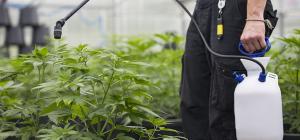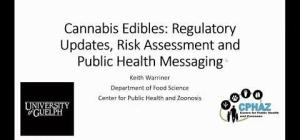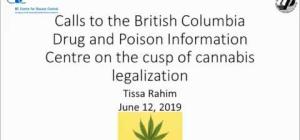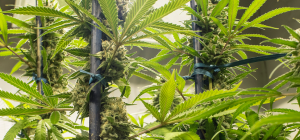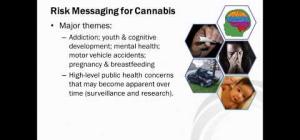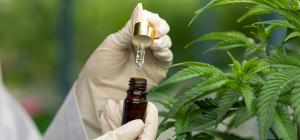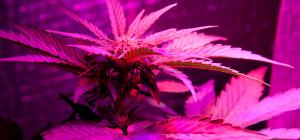
Cannabis resources for environmental health practitioners

This topic page is intended to help environmental health practitioners understand the guiding principles and public health objectives being used to develop cannabis policy, both federally and across the provinces and territories. It also provides key resources describing the “lessons learned” in non-Canadian jurisdictions with legalized cannabis, as well as information regarding environmental health risks in cannabis cultivation and processing (e.g., indoor air quality, chemical and biological contamination, and physical hazards). Finally, we provide resources on various aspects of cannabis regulation, including facilities inspections, packaging and labelling, approaches to edibles and concentrates, and requirements for cannabis laboratories.
NCCEH resources
- Public health and law enforcement in partnership: what does the public need to know about illegal cannabis? (NCCEH Seminar Series, 2021)
In this webinar, presenters from the BC Cannabis Secretariat and the Ontario Provincial Police discuss recent projects looking at contamination in illegal cannabis and the need for broader collaboration between regulators, law enforcement and public health when communicating with Canadians about the potential risks of illegal cannabis use.
- Unregulated Cannabis: Risky Production Practices Raise Concern for Consumers (Eykelbosh, 2021)
This blog describes a recent pilot study in which the NCCEH partnered with BC’s Cannabis Legalization and Regulation Secretariat to analyze pesticides and other contaminants in a small sample of dried bud products from Metro Vancouver.
- Elucidating the community health impacts of odours using citizen science and mobile monitoring (Eykelbosh et al. 2021)
This article provides a brief overview of some of the ways in which odour can impact public health. It also introduces Smell Vancouver, a citizen-science based odour mapping project, which aims to delineate the “smellscape” of Metro Vancouver and involves collaboration from the University of British Columbia, the BC Centre for Disease Control, and the NCCEH. The broader goals of the project are to understand how air quality and odours impact communities and health; cannabis cultivation will be one of the odour sources examined.
- Contaminants in black market cannabis: Consumers need answers (2020)
This blog introduces some of the concerns around the persistence of the illegal cannabis industry, despite legalization, and the knowledge gap around potential misuse of pesticides in unregulated product
- Cannabis edibles: Regulatory updates, risk assessment and public health messaging (Warriner, 2019)
This NCCEH webinar, which followed the legalization of edibles in October 2019, presented a risk assessment framework for cannabis edibles, detailing risk identification, characterization, management options and communication strategies.
- How we talk about “pot” matters: strategies for improved cannabis risk communication (Steiner et al., 2019)
This commentary summarizes some of the key messages regarding cannabis risk communication. It includes information and resources on cannabis terminology, contextualizing health evidence, avoiding stigmatization, promoting harm reduction, and the importance of de-complexifying new laws and regulations.
- Growing Cannabis Safely at Home (Steiner et al., 2019)
This video summarizes the key messages from NCCEH’s previous evidence review entitled Growing at Home: Health and Safety Concerns for Personal Cannabis Cultivation. The aim of this video is to identify key risks and mitigating actions for members of the public who wish to grow cannabis in their own home. Risks covered include access and accidental poisoning, indoor air quality issues, use of pesticides, electrical and fire hazards, and radiation hazards. Please contact NCCEH ([email protected]) for details on how to link to or embed this video into your website.
- Calls to the BC Drug and Poison Information Centre on the Cusp of Cannabis Legalization (Rahim, 2019)
This seminar, which was presented as part of the NCCEH Environmental Health Seminar Series, details recent efforts to understand cannabis misuse and its adverse effects among members of the public based on calls to BC’s Drug and Poison Information Center.
- Cultivation, consumption, and complexity - cannabis legalization day in Canada (Steiner, 2018)
This blog published on the eve of legalization comments briefly on some of the most frequently asked questions regarding the new cannabis legislation.
- Growing at Home: Health and Safety Concerns for Personal Cannabis Cultivation (Eykelbosh, 2018)
This evidence review identifies health and safety concerns that may be relevant to personal cultivation after cannabis legalization. The document is focused on five key environmental health risks anticipated from growing at home: 1) access and accidental poisoning; 2) indoor air quality; 3) inappropriate use of pesticides; 4) electrical and fire hazards; and 5) radiation hazards. The authors identify policy considerations relevant to each risk, highlight interventions that have been implemented in other jurisdictions, and suggest possible policy options that may mitigate some of these risks.
- Fact sheet: Environmental Health Risks of Personal Cannabis Cultivation (Steiner, 2018)
This fact sheet identifies health and safety concerns that may be relevant for personal cultivation and recommends key messages to help mitigate some of these risks.
- How We Talk about "Pot" Matters: Risk Messaging around Cannabis Legalization (Eykelbosh, 2017)
This presentation, originally delivered at the 2017 CIPHI Annual Education Conference in Richmond, BC, provides an overview of some basic risk communication principles as they pertain to cannabis legalization in Canada, and provides suggestions and examples for those shaping public health risk messaging.
- Recommendations for Safe Re-occupancy of Marijuana Grow Operations (NCCEH, 2009)
This guidance document provides information on safety considerations and remediation of residences previously used for illicit cannabis cultivation. Hazards commonly encountered in former grow operations including physical/structural damage, electrical or fire hazards related to manipulation of the home’s power supply, biological hazards related to humidity and mould, and chemical hazards due to the presence of pesticides, solvents, and fertilizers.
Selected external resources
Regulating cannabis in Canada
- Cannabis resource page (Health Canada, 2021)
This website hosts Health Canada’s resources on cannabis, including legalization, health effects and addiction research, cannabis risk communication, medical use, cannabis tourism, and resources for industry.
- Good production practices guide for cannabis (Government of Canada, 2019)
This guidance document details the requirements that licensed producers must satisfy to ensure that their cannabis is free of contaminants or other hazards, with additional linked resources on cannabis recalls, adverse reactions, and testing for pesticides and residual solvents.
- Regulations Amending the Cannabis Regulations (New Classes of Cannabis) (Health Canada, 2019)
This website details the new regulations governing edibles and other new classes of legal cannabis. These are amendments to the current federal Cannabis Regulations, under the Cannabis Act, which will come into effect on October 17th, 2019.
- Municipal guide to cannabis legalization: a roadmap for Canadian local governments (Federation of Canadian Municipalities, 2018)
This guidance document offers policy options and practical suggests for local cannabis rules and by-laws. The document focuses on the federal framework, land use management, business regulation, public consumption, cannabis in the workplace, and enforcement issues.
A public health approach to cannabis legalization
- Canadian cannabis survey 2020: Summary (Health Canada 2021)
This summary of the most recent national cannabis survey provides data on cannabis use, source, exposure to secondhand smoke, home growth or preparation, and effects of the pandemic.
- CPHA cannabis resources (Canadian Public Health Association, 2021)
This website compiles provides key information on cannabis health effects, as well as a compilation of resources and document on cannabis legalization and regulation, and resources for health providers wishing to communicate about cannabis use.
- Assessing public health messaging about cannabis edibles: perspectives from Canadian young adults (Ventresca et al. 2021)
This peer-reviewed article provides public health practitioners with valuable insight into cannabis risk communication for Canadians.
- Regulating private and public places of non-medical cannabis consumption in North America: Public health and public safety issues (Gourdet et al. 2021)
This peer-reviewed article looks at how legislation in the US and Canada has been used to regulate cannabis consumption in public spaces, both indoors and outdoors. The authors also examine how these restrictions (or lack thereof) may impact public health.
- Lower-risk cannabis use guidelines (LRCUG) for reducing health harms from non-medical cannabis use: A comprehensive evidence and recommendations update (Fischer et al. 2021)
These guidelines, developed in partnership by addiction and health experts (and endorsed by several key Canadian public health organizations), provide evidence-based recommendations on how public health entities can promote lower-risk behaviours among cannabis users. A bullet summary of these recommendations, based on the initial 2017 version of this paper, is available here.
- The health effects of cannabis and cannabinoids: the current state of evidence and recommendations for research (NASEM, 2017)
This evidence review provides a comprehensive synthesis of the cannabis health effects literature dating back to 1999, and helps to contextualize the evidence by identifying where health claims are supported by insufficient, limited, moderate, substantial, or conclusive evidence.
- Public health perspectives on cannabis policy and regulation (Chief Medical Officers of Health of Canada & Urban Public Health Network, 2016)
This report provides a consensus perspective on cannabis legalization from Medical Officers of Health from across English Canada. The document provides clarity on critical public health objectives within the context of legalization and provides jurisdictions with a set of guiding principles for policy development.
- A framework for the legalization and regulation of cannabis in Canada (Task Force on Cannabis Regulation and Legalization, 2016)
This report summarizes the recommendations of the Task Force regarding cannabis legalization, which were developed through online and in-person consultation with provincial, territorial, and municipal governments, as well as Indigenous governments, researchers and academics, non-governmental organizations, healthcare associations, and industry groups. The report provides a public health approach to legalization, with a focus on minimizing harm, establishing a safe supply, enforcing public safety, ensuring continued medical access.
Environmental health risks associated with cannabis cultivation
-
Why you need to drop your dealer (Ontario Provincial Police, 2021)
This media release describes recent studies conducted by the OPP into contaminants commonly found in illegally produced cannabis in Ontario. Consistent with the NCCEH report mentioned above, illegal dried cannabis samples were frequently contaminated with high levels of myclobutanil and other pesticides, and vape products often over-represented the amount of THC present. -
Analysis of illicit and legal cannabis products for a suite of chemical and microbial contaminants: A comparative study (Botelho et al. 2021)
This report compares the microbiological and chemical quality of cannabis samples obtained from licensed vs. illegal sources. The study looked at potency claims (%THC and CBD), microorganisms such as bacteria, yeast, and mould, as well as pesticides and heavy metals. - Measuring indoor fine particle concentrations, emission rates, and decay rates from cannabis use in a residence (Ott et al., 2021).
This peer-reviewed article provides some baseline data for estimating exposure to particulate matter when smoking or vaping cannabis or tobacco. - Pesticides in cannabis: A review of analytical and toxicological considerations (Taylor and Birkett, 2020)
This peer-reviewed article provides the most recent, comprehensive overview of the pest control products that are potentially used on cannabis and their degree of hazard and identifies some of the issues with assessing human health risk, such as the lack of data on those compounds produce when cannabis is burned.
- Clearing the air: A study of cannabis-related presentations to urban Alberta emergency departments following legalization (Yeung et al., 2020)
This peer-reviewed article examines trends in cannabis-related presentation to the ER, as well as cannabis-related calls to the provincial poison control centre.
- Potential regional air quality impacts of cannabis cultivation facilities in Denver, Colorado (Wang et al., 2019)
This peer-reviewed article estimated the emissions of highly odours volatile organic compounds (terpenes) from the approximately 600 registered cannabis cultivation facilities in Denver. The aim was to understand the impact of these emissions on local air quality due to atmospheric reactions that could create ozone, a respiratory irritant.
- Evidence brief: odours from cannabis production (Public Health Ontario, 2018)
This evidence review assesses the literature on potential health effects related to odour producing emissions associated with cannabis production facilities. Findings suggested that no studies on health effects associated with exposure to cannabis odour were identified, that odours can result in annoyance and complaints, and that a system to report and track odour could help local authorities remedy potential problems.
- Consequences of Largescale Production of Marijuana in Residential Buildings (Johnson and Miller, 2011)
This peer-reviewed article models residential moisture burdens (humidity) caused by indoor cannabis cultivation in three climatically contrasting Canadian cities. Notably, additional moisture from even small numbers of plants was estimated to exceed many homes’ ventilation capacity under some conditions.
Cannabis edibles
- A comparative analysis of laws on recreational cannabis edibles between Canada and the United States of America (Goundar et al., 2021)
This peer-reviewed article provides the most recent overview of the regulatory approaches to cannabis edibles in North America.
- Mitigating potential public health problems associated with edible cannabis products through adequate regulation: A landscape analysis (Soroosh et al. 2020)
This peer-reviewed article reviews cannabis edibles regulations in 56 American jurisdictions, the goal of which was to assist newly legalizing jurisdictions to develop regulations that support food safety and a harm reduction approach.
- Cannabis-infused edible products in Colorado: Food safety and public health implications (White et al., 2020)
This peer-reviewed article provides an overview of cannabis-associated food safety hazards and some examples of past investigations in Colorado.
- Food safety guidance for cannabis-infused products (National Environmental Health Association, 2018)
This guidance document summarizes the key concerns regarding cannabis food safety and an overview of applicable American regulations.
- How four U.S. states are regulating recreational marijuana edibles (Gourdet et al., 2017)
This peer-reviewed article provides an overview of edibles regulation in four American states. It provides a detailed analysis of labelling and packaging requirements as well as information on safe handling of edibles. This is a highly recommended resource.
Occupational exposures and health risks
- Health and safety in cannabis cultivation (WorkSafeBC, 2021)
This guidance document presents the findings of a recent health hazard assessment looking at the various potential hazards of cannabis cultivation and processing, including the use of chemical, microbiological contamination, and lighting.
- Determination of eighty-two pesticides and application to screening pesticides in cannabis growing facilities (Craven et al. 2021)
This peer-reviewed article describes a novel wipe-sampling method to sample for pesticides in the grow environment and tests its use in a legal and an illegal cannabis cultivation facility.
- Characterization of occupational exposure to airborne contaminants in an indoor cannabis production facility (Silvey et al. 2020)
This peer-reviewed article looked at particulate matter and volatile organic compounds in indoor door collected from different task-specific areas of a cannabis cultivation and processing facility.
- Review of NIOSH cannabis-related health hazard evaluations and research (Couch et al., 2020)
This report details the findings of a health hazard assessment that looked at microbiological and chemical findings throughout a grow facility and makes several recommendations for employers to reduce occupational exposures.
- Commercial cannabis production in British Columbia: Best available control technologies and regulatory oversight of environmental considerations (Upland Agricultural Consulting, 2019)
This guidance document provides an overview of the technologies to minimize the environmental impacts of cannabis cultivation facilities, including odor and other solid and liquid waste discharges.
This list is not intended to be exhaustive. Omission of a resource does not preclude it from having value.

